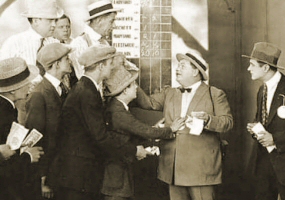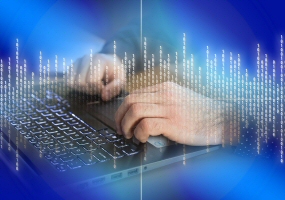How Oddsmakers Determine Sports Lines
How Sportsbook Oddsmakers Set the Betting Lines

Placing a wager with a retail or online sportsbook isn’t as simple as betting $20 against your buddy on the afternoon game. It’s not just about who you think will win. With professional bookie sites, it’s about how much you stand to win, if you’re right. That amount is determined by a group known as the almighty oddsmakers. These are the people who work behind the scenes to determine the lines for sportsbooks, which in turn post those lines for us to bet on.
If you’ve ever wondered where the oddsmakers get their information, how they determine the odds, or why lines tend to shift right up until game time, keep reading. We’ll teach you all about it, from the earliest days of legalized gambling in Las Vegas, to the future of oddsmaking to come.
The Birth of the Almighty Oddsmakers |
|
In the beginning, oddsmakers were the backroom brains that powered Las Vegas sportsbooks. From their shadowy nook, these diligent accountants decided who they thought would win, and by how much, based on their mathematical prowess and elevated knowledge of sports. They set the opening odds to reflect their opined probabilities, then tacked on a commission fee of 5-10%, known as “juice”, or “vig”. Juice was added to every betting line so that the sportsbook is guaranteed to make a profit – provided the public wagers pretty evenly on both sides of an event.
With every bet that came in, the oddsmakers would quickly calculate the total risk undertaken by the sportsbook. Anytime the risk began to sway too heavily to one side, the oddsmakers would swipe their mighty eraser across the board, chalking in new lines. Each shift was meant to encourage betting on the other side – “balancing the books”, as it were – to ensure the bookie makes a profit, regardless of the outcome. But that didn’t always work. When game time was nearing, if public betting remained uneven, putting a sportsbook at risk of a major loss, the oddsmakers would make a quick phone call of their own. They would place a bet on behalf of their client – the sportsbook – sized just right to create a perfect balance in their books. In this way, it wasn’t just the oddsmakers’ job to predict the genuine outcome of a game, but more importantly, to guarantee a profit for the Las Vegas bookies. The job of the oddsmaker got easier as they devised a technique known as “power ratings”. These ratings provided a more accurate means of predicting results. They were able to compare various strengths and weaknesses among athletes and teams. This intricate, point-based rating system made it far easier to set opening prices and create a level playing field with point spreads. |
How Sportsbooks Set Betting Lines Today |
|
Technology has changed (almost) everything about the way oddsmakers set sports lines in the modern age. Computers gave them the ability to input power rating data that, in turn, produced instant odd-factoring probabilities. Injecting each wager into the system as it is placed tells the oddsmakers whether it is necessary to shift the lines. Basically, computer technology removes the risk of human error from their calculations, speeding up the process of line determination a thousand-fold.
The results are so fluent these days, it’s rare for a single bookmaker to hire its own personal oddsmakers. Instead, there are a few major companies out there that set odds, while sportsbooks all over the globe outsource these companies to supply their lines. This is why the betting lines from one sportsbooks to the next look like virtual mirror images. Only the shifting lines tend to differ, but rarely by much.
|
What the Future of Oddsmaking Means for Gamblers |
|
As you probably surmised from what you’ve just learned, it was far easier for gamblers to make money in the early days of sports betting. Sure, it took more effort to call up each bookie to get their lines. The internet didn’t exist in those days. Likewise, the chances of every bookmaker posting the same lines were not nearly so high, so it was absolutely worth the effort. As technology became more prevalent, bettors found that more and more bookies were working in tandem. Today, there are only a handful of major oddsmakers supplying lines for the global industry. For the above-average bettor – the part-time strategists, full-time handicappers, and elite sharps – this means you’re going to need to do some serious homework to find value in the market. The future of the oddsmaking industry is not going to make things any easier for sports betting aficionados. It will continue to improve the accuracy of profit margins for sportsbooks, because that’s who oddsmakers have always served. But for us bettors, persevering diligence will be the key to continued success. Think of the progression of oddsmaking like centuries of evolving success in weather predictions. Hundreds of years ago, scientists looked up at the sky and determined it would rain, simply because the clouds were thick and dark. Over time, they learned to examine things like the tint of the horizon at dusk, and the shapes and density of the clouds. Technology gave them access to weather charts, broad spectrum radars and eventually computer-based meteorological tools. Now, the weather can be predicted with over 95% accuracy. In this way – combining significant accuracy with juice and book balancing techniques – the sportsbook industry is guaranteed to continuing thriving for as long as there are sports fans willing to place wagers. |
What Competition Means to Bettors |
|
The biggest advantage we, the bettors, have left, is competition. The sports betting industry – not just here in Indiana, but across the United States and beyond – is spurred on by competition. There are more than a dozen retail sportsbooks in The Hoosier State alone, and nearly as many operating in the digital space. Each and every one – but especially the mobile variety – must compete for customers. This means offering greater promotions, a wider selection of sports, and most importantly, competitive lines. The average bettor may not understand the importance of comparing lines and following their shifts, but the marginal few who manage to secure a long-term profit of 55-65% do. They understand that the more options they have, the more opportunities they’ll find to hedge bets, much the same way sportsbooks do. Without the growing rate of competition in the market, even the most successful professionals might be out looking for a day job soon enough. |
Legal Indiana Sports Betting in 2021
 BetRivers is licensed and regulated on a state level by Indiana to operate legally. It offers a wide range of sport betting options – every popular game is covered. Mobile options are also covered for an “on-the-go” experience. Our editor pick for safe and legal betting in 2021.
BetRivers is licensed and regulated on a state level by Indiana to operate legally. It offers a wide range of sport betting options – every popular game is covered. Mobile options are also covered for an “on-the-go” experience. Our editor pick for safe and legal betting in 2021.

 Once the oddsmakers set their lines, the bookmaker opened their phones to the public and sent their bookies into the street. Every wager that came in was recorded, by hand, in an actual book (hence the terms “bookie” and “bookmaker”). Back in the oddsmakers room, the current odds for each game were written on a chalkboard – a practice that made it very easy to make any necessary adjustments.
Once the oddsmakers set their lines, the bookmaker opened their phones to the public and sent their bookies into the street. Every wager that came in was recorded, by hand, in an actual book (hence the terms “bookie” and “bookmaker”). Back in the oddsmakers room, the current odds for each game were written on a chalkboard – a practice that made it very easy to make any necessary adjustments. Today, it’s a combination of human engineers and computer programs that are responsible for the betting odds we see at retail and online sportsbooks. the power rating system is still used, although it takes far more data and statistics into consideration, crunching countless bits of information to produce a highly probable prediction. Thanks to technology, oddsmakers are able to perform this task for every athlete, in every game, across every sport.
Today, it’s a combination of human engineers and computer programs that are responsible for the betting odds we see at retail and online sportsbooks. the power rating system is still used, although it takes far more data and statistics into consideration, crunching countless bits of information to produce a highly probable prediction. Thanks to technology, oddsmakers are able to perform this task for every athlete, in every game, across every sport.
